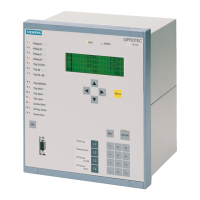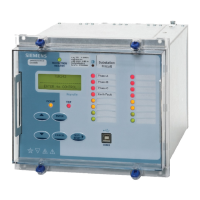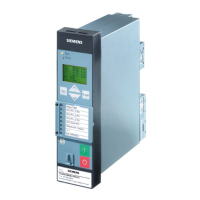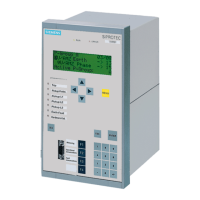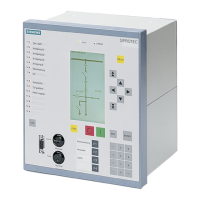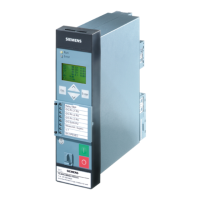16
Bench Testing
7UT51 v3
176 PRIM-2330C
Expected Results:
The warning alarm should occur within the larger of +/-
12% or +/- 2 seconds of the calculated 49 T
warn
.
With the default settings and the changes made, LED
4 should light and the contact of Signal Relay 1 should
close several seconds after the application of current
(the actual time is not important). When the
temperature warning occurs, LED 3 and Signal Relay
2 should operate. If 49 does not trip, no other target or
contact operations should occur. The LCD should
show “49 O/L1 PU Θ” or “49 O/L2 PU Θ”. LED 3 and
Signal Relay 2 should not reset immediately after the
current is off. The 7UT51 will calculate the
temperature as still being above the alarm point, until
a cool-down period occurs.
16.7.3 49 Tripping: Addresses
2402 and 2403 (49
-
1), 2502
and 2503 (49
-
2)
Perform this test for 49-1 only if Address 2401 =
On
.
Perform this test for 49-2 only if Address 2501 =
On
.
Connect the 7UT51 using the example and the
accompanying Figure 16.13. Connect the contact of
Trip Relay 1 to the timer.
49
-
1 Tripping
1. Set Address 2401 = OFF. Wait at least one
minute with this setting. Set up the test during the
wait.
2. If Section 16.7.2 on page 175 was done, use the
same Source 1 current. Otherwise, any Source 1
current magnitude between {[1.2 X Address 2402
X I
NsecWx
] or [1.2 X Address 2402 X I
Objsec
]} and
20 amps (4 amps) can be used. The trip time
decreases as current increases. The following is
recommended. If 49-1 T
trip
< 2 minutes for a
current of 20 amps (4 amps), lower the current to
get a trip time of about 2 minutes. If 49-1 T
trip
> 2
minutes for a current of 20 amps (4 amps), use
this maximum current.
3. Set the timer to start on the application of current,
and stop on the closure of the Trip Relay 1
contact.
4. Set Address 2401 =
On
.
5. Apply the current.
6. Observe the LEDs and the Signal Relay 1 contact
during the test.
7. Turn OFF the current, after a trip, as soon as
practical. This will save time in reading the LCD.
8. Record the value from the timer.
9. Record the LEDs. Wait for the LCD and record.
Reset.
10. Follow step 1 if any other testing is done.
49
-
2 Tripping
Follow steps 1-10 for 49-1 tripping except use
Address 2501 in steps 1 and 4, Address 2502 in step
2, and 49-2 T
trip
in step 2.
Expected Results
The trip time should occur within the larger of +/- 12%
or +/- 2 seconds of the calculated 49-1 T
trip
or 49-2
T
trip
.
After several seconds of the current application (the
actual time is not important), LED 4 should light and
the contact of Signal Relay 1 should close. The
warning should occur at about the same time as in
Section 16.7.2 on page 175 if the same test current is
used. LED 3 and Signal Relay 2 should operate. At
tripping, with the default settings and the changes
made, all of the trip contacts should close, contacts of
Signal Relays 1, 2, 6 and 7 should be toggled, and
LEDs 1, 2, 3, 4, and 9 (49-1) or 10 (49-2) should be lit.
When the current is turned off, the contact of Signal
Relay 1 should open and LED 4 should go out. After
some time – perhaps minutes – the trip contacts
should open, Signal Relay 6 should reset, and LED 2
should go out (the 7UT51 is still calculating
temperature with the current off). Later, LED 3 should
go out and Signal Relays 2 and 7 should reset. The
other LEDs have memory. The LCD should display “
49
O/L1 PU Θ
ΘΘ
Θ” and “
49 O/L1 TRIP
”, or “
49 O/L2 PU Θ
ΘΘ
Θ”
and “
49 O/L2 TRIP
”, after LED 2 goes out (49 trip
resets).
Reset Relay
Reset 7UT51 for desired settings. Program Trip Relay
1, Signal Relays 1 and 2, and LED 2,3, and 4 for the
desired settings. If 49 warning or trip times were
decreased for testing purposes, reset addresses 2403
and 2503 to the original settings. Be sure addresses
2401 and 2501 have the proper settings. Reset any
other addresses changed for testing purposes.

